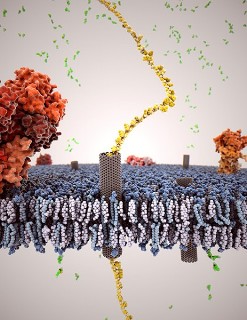Apr 10 2015
Researchers have succeeded in developing a technique for spontaneous insertion of carbon nanotubes (CNT) into synthetic and natural cell membranes to create pores imitating biological channels.
 Depiction of carbon nanotube (gray) inserted into a cell membrane, with a single strand of DNA (gold) passing through the nanotube. Image courtesy of Lawrence Livermore National Laboratory
Depiction of carbon nanotube (gray) inserted into a cell membrane, with a single strand of DNA (gold) passing through the nanotube. Image courtesy of Lawrence Livermore National Laboratory
Though these CNT-membrane pores have a highly simplified structure, they imitate the key functional behaviors of protein-based biological channels (porins), which enable selective transportation of water, ions, protons and small molecules.
It is a challenge to create and develop strong synthetic materials that simulate the high effectiveness and selective transport processes of biological channels. The developed CNT porins hold promise as biomimetic platforms for nanofluidic studies, constructing synthetic cells and bioelectronic interfaces, and serve as major components for membrane-based separation systems, which are highly energy efficient.
CNTs are considered to be ideal for simulating biological transport since they have a similar pore structure to key biological channels, and it is possible that based on computational modeling, they can insert themselves into biological membranes. The development of this kind of hybrid membrane structure has become a great challenge. The research team includes scientists at Lawrence Livermore National Laboratory and Lawrence Berkeley National Laboratory, the University of California at Berkeley, and the University of Basque Country in Spain.
According to the researchers, CNTs functionalized with lipid (fatty) molecules insert spontaneously into synthetic and natural cell membranes. Long CNTs cannot directly interface with a real biological system, which is very much possible with small CNTs which are inserted into live cell walls.
The basic physics of nanopore transport was studied using this interface with a model that has very close approximations to an ion channel and that imitates transport in biological pores.
The integrity of the membrane is not affected by the CNTs. Using electron microscopy, it was shown that insertion is not selective to the length of a specific nanotube. In contrast with prior simulation-based forecasts, a near-perpendicular CNT orientation is very much favored inside the membrane.
In spite of considerable length variations of the CNTs, the transport characteristics of these hybrid membranes, called CNT porins, are well-defined, showing that transport via the CNT pores is directed by only the barriers at the exit and entry of the pore. Furthermore, nanoscale confinement of ions in narrow hydrophobic channel results in ionic current fluctuation, imitating the on-off gating technique of ion transport taking place in biological channels.
These results indicate the creation of hybrid materials with practical membrane applications. These applications include offering a basis for nanofluidic analysis, creation of artificial cells and interfaces and acting as major components for energy-efficient membrane separation systems.